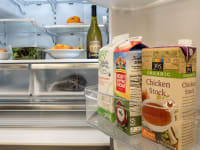10 things to consider when buying a refrigerator
Don't buy a fridge before you read this
 Credit:
Reviewed / Samsung / GE
Credit:
Reviewed / Samsung / GE
Products are chosen independently by our editors. Purchases made through our links may earn us a commission.
Buying a refrigerator means making a choice you’ll have to live with every day. It’s a big decision. Since there are so many styles and types of refrigerators, you have a lot of options to choose from.
Whether you can afford to spend under $800 for a basic model, or over $3,000 for a smart fridge with a ton of options, there’s a refrigerator out there calling your name. You just have to do some research before you click that "buy" button. Here's our checklist for buying the best refrigerator to suit your needs and budget.
Checklist: How to buy a refrigerator
This sequence will probably help you most, but go in any order, as long as you cover these points:
1. Measure, measure, measure
2. Decide on a style
3. Set a budget
4. Determine how much food storage you need
5. Choose a finish
6. Find the features you want
7. Visit stores and sites, and start a wish list
8. Read reviews
9. Select delivery and installation options
10. Plan for disposal of the old fridge
1. Measure, measure, measure
When it comes to buying a new fridge, you need to measure everything. First, start with where the fridge will live. Make sure the door won't hit an island or a wall. And be sure to leave some extra room—at least an inch all around for ventilation.
Then look at the path the fridge will enter to get into your kitchen. Fridges don't magically appear! Many deliveries end in frustration because the hallway door is too narrow or there's no clearance in the stairwell.
It may seem like overkill, but if you're living in a particularly tight space, you can even piece together a cardboard approximation of the fridge and test drive it from the entryway to your kitchen.
2. Style

The four most popular types of refrigerators. There are lots of ad-ons, features, and variations from here.
Most refrigerators fall into these main categories:
Top freezer: Your grandmother might have had one like this. The freezer is situated above the refrigerator compartment. Though they may look old school, these types of fridges can be very efficient. Generally top-freezers are the most affordable type. See our Best Top-freezer refrigerators for the ones we currently recommend.
Bottom freezer: Bottom-freezers are a cheaper alternative to French-door models, with some of the same advantages. Check out the Hisense HRB171N6ASE.
Side-by-side: Just like the name says, side-by-side models have the refrigerator and the freezer right next to one another, keeping most of your food at eye level. If you like lots of room to keep frozen foods like large frozen pizzas, pans of lasagna, similar wide foods, be sure the freezer compartment has room. Many of them don’t, and this can be a make-or-break issue for bakers trying to fit a baking sheet in the freezer. If you prefer the side-by-side look, we recommend the Samsung Bespoke RS28CB7600.
French-door: The most stylish look for refrigerators now, French-doors are bottom freezer models that have two refrigerator doors, and a freezer drawer on the bottom. There are a few common variants on the three-door French-door look, including the four-door version that has an additional pull-drawer, and a quad-door version.
And then there's width and depth to consider. While most fridges are approximately 36 inches wide, you can find some that are narrower. Then you'll need to consider if you want standard depth or counter-depth.
3. Budget
When buying refrigerators, one of the first concerns is price. In our testing at Reviewed, we’ve found excellent refrigerators at a variety of price points. Before you start shopping to buy a fridge, determine how much you’re able to spend. A basic, quality top freezer can cost under $800, while French-door fridges start closer to $1,200 and go up from there.
4. Storage

Flipping up, sliding out, and folding in: lots of shelf mobility makes for a versatile fridge.
The size of your kitchen and your family’s grocery habits will determine how many cubic feet of storage your refrigerator needs (and how much freezer space). While the footprint of the fridge (i.e. the exterior width and depth) may be restricted due to your kitchen design, there are fridges that make great use of space and those that don't.
In-door ice dispensers, for example, are convenient, but they do take up room that might otherwise hold more groceries.
Some fridges also have flex-shelves and customizable organization. Be sure to consider how you can customize the shelves and bins. You never know when you'll have to fit a sheet cake, a deli platter, and four bottles of wine.
5. Finish
Since you’re going to be looking at your refrigerator every day, choose a finish that looks great in your kitchen.
Stainless: The clean, metallic look of a stainless steel refrigerator is timeless. Many of today’s stainless refrigerators are smudgeproof, so you won’t spend hours polishing off fingerprints.
Black stainless steel: The up-and-coming finish, each brand has its own take on it, making it hard to mix brands. Black stainless resists fingerprints, making it easier to maintain. Although magnets will stick to most black stainless finishes, they can scratch easily, so think twice about using them.
Plain black or white: Select one of these classic finishes if you need to match the rest of your appliances. A fridge in black or white usually costs less than one in stainless or black stainless steel.
Other colors: From customizable door panels to bespoke colors you can find almost any finish or color you'd want if you're willing to pay extra.
6. Special features

Four doors, five doors, doors inside of doors! There are lots of cool options. Just be prepared to pay.
Bells and whistles might not be important to you, but if you want ice and water dispensers, gallon-size bins in the doors, adjustable shelves, and a door alarm (oh, yes), ensure that the models you’re considering have them. Nowadays, you can pick from fridges with craft ice makers, [smart featureshttps://brandcycle.go2cloud.org/aff_c?offer_id=1001&aff_id=9562&url=https%3A%2F%2Fclick.linksynergy.com%2Fdeeplink%3Fid%3DIZeqSRYHO5E%26mid%3D47773%26u1%3DA%7Baffiliate_id%7DO%7Boffer_id%7DTID%7Btransaction_id%7D%7Cbw-e21a7226-20c5%5B%5B%5B1f9ac9%5B%26murl%3Dhttps%3A%2F%2Fwww.samsung.com%2Fus%2Fhome-appliances%2Frefrigerators%2Fbespoke%2Fbespoke-29-cu-ft-4-door-french-door-refrigerator-with-ai-family-hub-ai-vision-inside-in-white-glass-rf90f29aewaa%2F&aff_unique3=d735f6cc-d74e-4245-8900-8cc716458171, door-in-door designs, air filters to keep produce fresh, and more. Below are some helpful features worth considering when selecting your new fridge.
Flex drawers: These temperature-controlled drawers are a popular new feature found on French-doors. You can use flex drawers to keep items at a set temperature that is either too warm or too cold to apply to your whole fridge.
Dual evaporators: While standard fridges use a single evaporator that cools both the freezer and refrigerator, dual evaporators use separate evaporators for each. This feature can help maintain better air quality throughout your fridge, which may help your fresh veggies last longer and help keep your fridge odor-free.
Air filters: As many fruits ripen, they release ethylene gas, which cause other fresh foods like fruits and vegetables to rot prematurely—that's why many fridges feature crisper drawers to separate your fruits and veggies and keep produce fresher for longer. Newer Bosch fridges, for instance, are aiming to solve this problem by integrating an ethylene gas filter into their fridges.
Smart home platforms: Many brands have outfitted their fridges with smart home platforms, each with a unique focus and suite of features. Samsung, for instance, is about home-wide interconnectedness, outfitting their fridges with a touchscreen you can use to check on your smart doorbell's video feed, order new groceries based on an automated inventory, or suggest recipes based on what you actually have in stock. LG is focused on data analytics. It collects your usage data and uses that to help you get even more out of the devices you own. Bosch's smart platform is all about personalization and customization.
7. Touch and feel
Your fridge is usually the most touched appliance in your home. Although they may look sleek when clean, stainless appliances can be prone to fingerprints, leading many brands to release appliance lines with smudge-proof finishes, such as black stainless steel.
If you close you eyes, you can probably recreate exactly what it feels like to open the door and make a grab for the milk. So how your new fridge feels is important as it looks. For instance, you may be interested in refrigerators with recessed handles, which can also provide a more modern look.
Even if you're buying online, it's worthwhile to stop by a brick-and-mortar store for some hands-on time. The exception here is secondary fridges that are headed for the basement or garage. Just go with whatever's affordable and has decent reviews. Speaking of reviews. …
8. Read the reviews

Reviewed's fridge lab monitors temperature and humidity to get precise data.
Check our site and others to see what experts and owners say. Not all refrigerators do a great job maintaining the appropriate temperatures to keep food safe.
User reviews, taken as a whole, can help uncover trends in quality and reliability. And don't forget personal recommendations from friends and family—often the most useful and personalized reviews of all.
9. Choose delivery options carefully
Delivery day can go smoothly or it can end in disaster. (See rule #1.) Appliance damage is most likely to occur not at the factory, but in the last fifty feet to your house. Once the truck arrives, all the protective cardboard and foam is ripped away.
Investigate the options. Some retailers include delivery and installation with the price you pay for the refrigerator, but don’t assume that’s always the case. Also, ask how your fridge is going to be delivered. If the delivery service uses a two-wheeler, protect your floors, stairs, and door moldings, or they may get damaged.
Make a careful inspection of the fridge before you give your signature. Examine the walls and floor of your house. Any scratches, dents, or holes? Once they leave, it can be much harder to plead your case.
10. Make disposal plans for the old fridge
You may have to pay extra to get your old refrigerator hauled away. Most retailers will haul it away from a nominal charge, but be sure to find out ahead of time. Otherwise you could end up having to take care of it yourself, and refrigerators are heavy.



